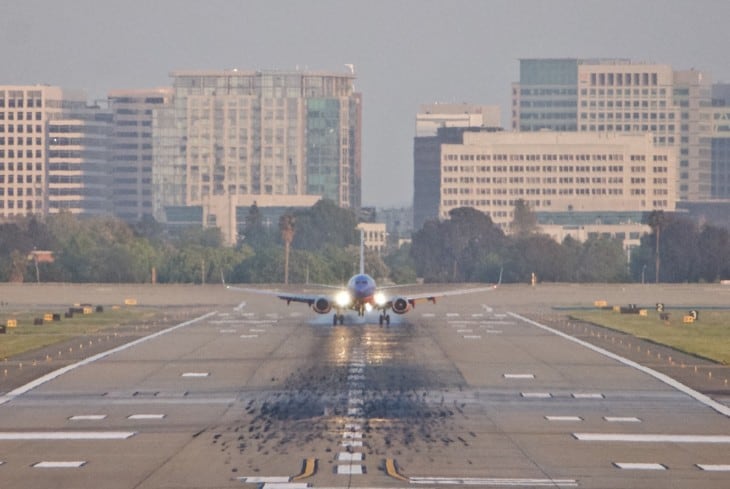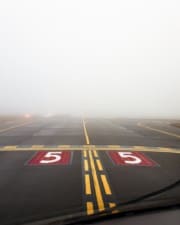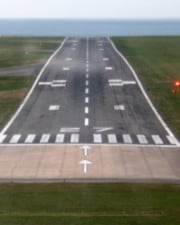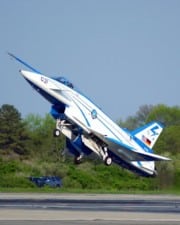Airports can be complicated places. They’re generally flat, with no easy to identify visual landmarks. There’s no standard layout or design–no usual way things are organized. Pilots visiting unfamiliar airports are at a considerable disadvantage, especially if the visibility is low or the weather is bad.
Table of Contents
To help them navigate safely, airport markings and signs are standardized the world over. Even still, it’s vitally important that pilots know where they are and where they are going when taxiing around the airport.
To accomplish this, pilots combine the painted markings and signs that they see out the cockpit window with charts and diagrams. At controlled fields, ATC provides careful clearances to guide pilots the right way.
Several of the worst aviation disasters have resulted from lost pilots straying onto active runways. When an aircraft is on a runway without permission, it is called a runway incursion. The runway should be clear and free of obstacles; it should be a safe zone for airplanes taking off or landing. These are critical times in a flight when there is no option to maneuver and get out of the way. It’s the responsibility of pilots to ensure that all runways they cross are not being used.
Making runway crossings clear and apparent is essential to aviation safety. These standards are continually being upgraded and changed as studies reveal new ways to draw attention to essential intersections and confusing areas to navigate.

Basic Runway Markings
When we discuss markings, we’re talking about the paint on the ground. Markings are analogous to highway lines and stripes. But there are a lot more markings at an airport.
The first thing to realize is that runway markings are always white. Everything else on the surface of the airport, like taxiways and ramps, is painted in yellow. If a yellow line is seen on a runway, it has something to do with a taxiway, not the runway. For example, you might see solid yellow lines curve to one side of the runway or the other, indicating the path you would take to join a taxiway.
Runway Numbers
Even the smallest runways have three basic features. The most obvious is a designator marking near each end. This number indicates the magnetic direction that the runway is oriented, so Runway 9 is pointed 090 degrees (due east), Runway 18 is pointed 180 degrees (due south), and Runway 36 is pointed 360 degrees (due north), and so on. The designator is rounded to the nearest ten.
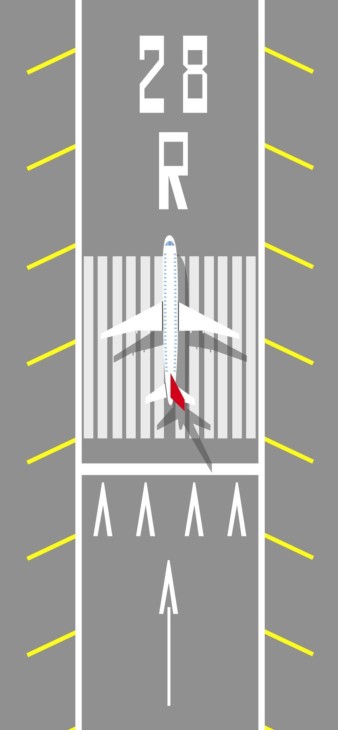
If an airport has two or three parallel runways with the same magnetic direction, they are designed Left and Right, or Left, Center, and Right in the case of three. For example, Fort Lauderdale International Airport in Florida has Runway 10L and Runway 10R when landing to the east. The same two runways are designed Runway 28L and Runway 28R when landing to the west.
It’s interesting to note that runway designators change over time because the earth’s magnetic field shifts a tiny bit each year. If you fly in the same area long enough, Runway 9 will eventually become Runway 10. When I first started flying in the 1990s, Fort Lauderdale had Runway 9L/27R and 9R/27L.
Runway Threshold Markings
All runways also mark their thresholds in some way. The most basic small airport runways use a solid bar that makes it apparent against the background.
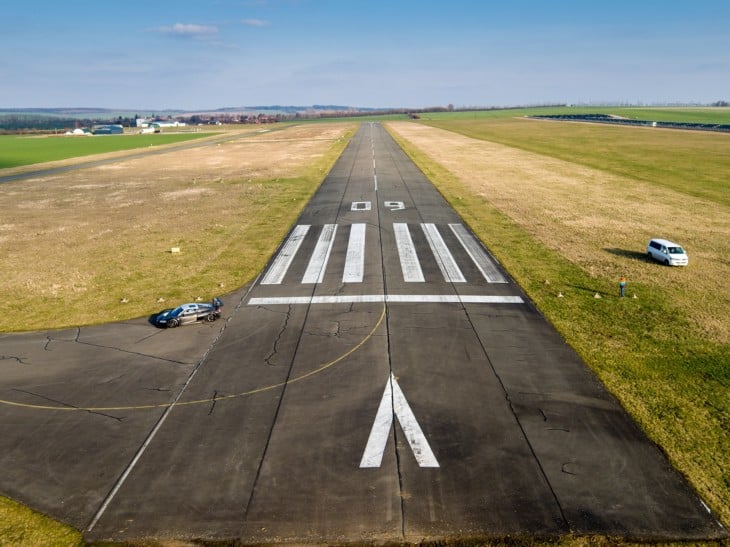
Centerline and Aim Point Markings
As runways get longer or are served by bigger airplanes, like jets or airlines, they get better markings.
Nearly all runways also have centerline stripes. These help the pilot aim for the middle of the runway. Unlike on the highway, the pilot keeps the middle of the plane right over the runway’s centerline. There are no passing lanes on a runway!
Centerline stripes are standardized to be precisely 200 feet between the start of one stripe and the beginning of another.
If a runway is over 4,000 feet long, it gets an aim point markings. These are two large white blocks located 1,000 feet from the threshold. The give the pilot a rough idea of where they should touch down. Aim point markings are 150 feet long.

What are the 3 Types of Runways?
According to the Aeronautical Information Manual, runways are divided into three different categories based on the instrument approach leading pilots to the runway. The runway described above is a basic visual runway that has no instrument approaches.
An instrument approach allows pilots to descend to the airport from altitude while visibility is low. It makes sense that if a pilot is on an approach and looking for a runway, then the runway markings should be bold enough to help the pilot spot it.
Non-precision approaches usually allow pilots to descend within 600 feet of the surface with about one mile of visibility. These restrictions mean that while a pilot can try to find the airport in bad weather, it’s not going to extremely fogged in or a torrential downpour when they try. Non-precision runways always have the four features mentioned above for increased visibility.
Precision approaches allow pilots to descend even lower in lower visibility. The minimums vary depending on the exact type of approach, but a regular ILS approach will allow pilots to get within 200 feet of the runway in a quarter to a half-mile of visibility. That’s pretty close to the ground without seeing the runway.
As a result, the runway is marked with everything mentioned above, plus sidelines on the edges and a distinctive touchdown zone marking. The touchdown zone markings are sets of white bars on each side of the runway, each 500 feet from the next. The threshold markings are enhanced and include a series of parallel white bars across the runway threshold, the number of bars depending on the width of the runway. All of this makes the runway more visible.
Real-World Results of Runway Markings
If a runway doesn’t have the right markings, it can affect the landing minima that the pilot must adhere to. For example, if there’s an approach but the right painted markings aren’t all present, the approach might have higher minimums than it would otherwise. Pilots then can’t make full use of the instrument approach simply because of a lack of runway markings.
Another possible area where the runway markings can help is during low visibility takeoffs. Only air carriers operating under Parts 121 or 135 have takeoff minimums, but it’s a good idea for all pilots to review them. Pilots should have adequate visual references when taking off in bad weather, and the better the runway markings, the better their visual references are.
Runway Intersections
Signs are standardized around airports, so the meaning of them should be apparent to pilots even as they pass quickly on a runway. The most important sign on an airport indicates that a pilot is about to cross a runway.

Runway intersections, whether two runways meet or a taxiway crosses a runway, are marked by red signs with white letters. They include the runway designator numbers. For example, this sign would indicate that the pilot is about to cross Runway 4-22. From the direction they are approaching, Runway 4 is to the left, and Runway 22 is on the right (they are the same piece of asphalt, but used in different directions.)
Land and Hold Short Operations (LAHSO)
When a runway is being crossed, there must be a place where controllers can tell the pilots to “hold short.” Hold short simply means to stop before crossing and wait for further clearance. It’s like an airport stop sign.

This is the hold short marking. It is painted on the ground in yellow. The pilot must always hold on the side with the solid bars. As they exit a runway, they will see the dashed lines and know that they must get on the other side of the hold short markings before they stop.
Sometimes the same symbol is printed on a yellow sign in black, drawing extra attention to the hold short markings on the ground. The area protected inside the hold short markings is properly called the runway safety area.

Some airports have Land and Hold Short Operations, or LAHSO. These airports have crossing runways, and they ask that pilots come to a stop and hold short on the runway after landing before they cross the intersecting runway. In this case, the pilot will see the hold short markings and signs on the runway.
Other Runway Signs
Airport signs come in four primary varieties. All of them could appear on the sides of a runway. They are–
Mandatory signs
Mandatory signs, which usually state runway crossings, like those discussed above, are red with white numbers or letters. Some mandatory signs tell a pilot they are near an ILS critical area, like the sign below.

Mandatory signs can also indicate closed areas, like this one that means, “Do not enter.”
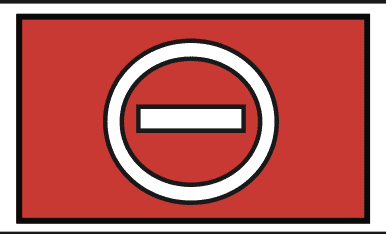
Informational signs
Informational signs are yellow signs with black letters. They tell you things you need to know, like which way to turn or what to do. For example, in the sign below, the pilot is told to make a right turn if they want to turn onto Taxiway Juliet.

This sign reminds pilots of the local noise abatement procedures.

Location signs
Location signs are black signs with yellow letters. They tell you where you are. In the signs below, the aircraft is located on Taxiway Bravo. If the location is a number, you are on a runway–Runway 22 in this example.


Runway distance signs
Runway distance remaining markers are black signs with white numbers that appear on the side of a runway. They count down the remaining runway in thousands of feet. For example, the following sign means there are 7,000 feet of runway remaining.

Some airports have begun painting the signs on the asphalt as well as making physical signs. It doesn’t mean anything different; it’s just another tactic to draw attention to something important.
Special Runway Thresholds
Most runways start where the pavement starts, but there are two special exceptions.
A displaced threshold is an area where pilots can taxi and takeoff, but they cannot land. The landing threshold is displaced some distance so that the landing distance available is less than the takeoff distance.
Why would this happen? It occurs when there is a hazardous obstacle near the landing approach, like a tall building, a highway overpass, or a hill. If the pilot were landing on the opposite runway, they could use this space for the rollout.
Displaced thresholds are shown with white arrows pointing to the threshold.
A blast pad is a paved portion on the end of the runway that is unavailable for taxi, takeoff, or landing. Painted yellow chevrons indicate it.

Runway Lights
Just like painted markings do, lights indicate certain things at airports. Runway edge lights are white, except for the last 3,000 feet of the runway where they alternate white and yellow.
Runway thresholds are marked with green lights on the approaching side and red lights on the departure side. When lined up with a runway, the threshold is shown in green, and the far end is shown in red.
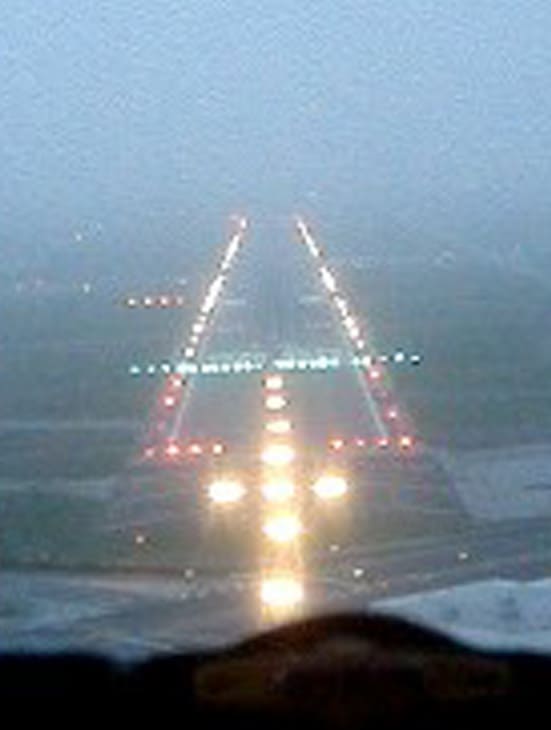
Some runways have centerline lights. They are white as well, except for the last 1,000 feet when the alternate white and red.
Finally, the approach end of runways that are served by instrument approaches often have distinctive sequenced and flashing white lights to help pilots alight the plane with the runway in low visibility. There are a bunch of different layouts and types of approach light systems (ALS). You can see a full table of them in the AIM.
Runway Closures
The final runway marking you might see is pretty easy to figure out. If you see a giant yellow “X” on a runway, it means that the runway is closed. If it is a permanent closure, the X is painted on the surface, and all other markings are removed. If it is temporary, giant, moveable lighted X’s will be placed over the numbers.

Related Posts
